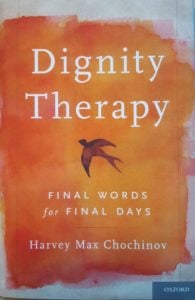
Dignity Therapy is a remarkable book. From one perspective, however, that is not surprising, as it has a remarkable author, Dr Harvey Max Chochinov.
(Note: In this review I refer to the book as Dignity Therapy in italics and the psychotherapeutic intervention it explains as “dignity therapy” in quotation marks.)
Dr Chochinov is a Canadian psychiatrist who has specialised in psychiatric treatment for terminally ill people. His work in this context has won him international renown as a clinician and researcher. But what shines through most strongly throughout this entire book is his deep humanity and commitment to caring for and healing his fellow human beings who are dying.

Dignity Therapy is, first of all, a “how to” manual for health-care professionals wanting to use this therapeutic intervention. But in employing case studies to describe how to do that, it also teaches all of us what dying people need if they are to have the best chance of experiencing a “good death”. As well, and very importantly in the current societal context of the push to legalise physician-assisted suicide and euthanasia (PAS-E), those cases also show us what we would lose as human beings by accepting those interventions to cut short the time and experiences we can have at the end of life.
“Dignity therapy” is a response developed by Dr Chochinov to a research finding that in 57 per cent of cases in which Dutch physicians had undertaken euthanasia the reason given was the patient’s “loss of dignity”, whereas in only 5 per cent of cases was the reason pain. (p5) So, if we believe that euthanasia is a bad and dangerous idea, we need to prevent or at least mitigate a loss of dignity.
Loss of dignity encompasses perceiving a loss of respect from others, feeling a burden on others and having nothing to give in return, loss of meaning, loss of hope and loss of one’s sense of self. “Dignity therapy” is a psychotherapeutic intervention that seeks to ameliorate these losses through a “dignity-conserving repertoire” that includes fostering the person’s sense of “continuity of self”, enabling their “role preservation”, promoting “generativity” that is helping them to leave a legacy, encouraging “maintenance of pride”, and eliciting both hopefulness and resilience and fighting spirit.
Practices that promote such outcomes include maintaining normalcy to the greatest extent possible, seeking spiritual comfort and living in the moment. Here is a description of that last practice:
“Living in the moment is what people do when they are able to stop themselves from what can turn into overwhelming ‘forward thinking’. Taking in the here and now can provide tremendous comfort, offering moments of human contact, love, celebration, humour, affirmation, and, on occasion, even reconciliation. Despite a limited prognosis, people are disinclined to constantly stare that particular reality in the face. Living in the moment is a comforting form of engagement, and it is this very engagement that can transform the final phase of life into a time of living, rather than simply a time of anticipating death. (Emphasis added) (p24)
Hope is the oxygen of the human spirit. It is to our spirit as breathing is to our body. Without hope our spirit dies, with it we can overcome even seemingly insurmountable obstacles. Hope requires a sense of connection to the future, but that future can be quite close and can include creating a legacy to leave to others after we’ve gone. So, looking forward to a visit from a loved one or, as in “dignity therapy”, writing a memoir to leave to others, can generate hope. . They found that hopelessness, which is distinguished from depression, was strongly associated with requests for euthanasia.
Dignity Therapy sets out a “Social Dignity Inventory” that examines “Privacy Boundaries”, “Social Support”, “Burden to Others”, “Aftermath Concerns” and “Care Tenor”. The last topic is the most extensively explored in this section and includes Dr Chochinov’s renowned A, B, C, D for health-care professionals of “dignity-preserving care”.
A is for attitude towards patients: they must be valued and treated with respect. B is behaviour – a smile, a touch, a kind gesture. He tells the intensely moving story of the palliative care doctor who took the time to feed a dying man a clear broth, whose only words to her were: “I can never find a way of thanking you for what you’ve just done for me.” (p30) C is for compassion: “a deep awareness (of), and the wish to relieve, the suffering of another”. D is for dialogue: “the nature of the conversations that occur between health-care providers and patients”. (Pp.30–31)
Dr Chochinov and his co-researchers identified the components of dignity and then looked at how they could be implemented to enhance dying people’s feelings of both dignity and being treated with respect. This approach is called “dignity conserving care”. They also developed as a part of such care, a specific, brief, psychotherapeutic intervention they called “dignity therapy”, which facilitates the creation of a legacy document. Here’s a summary of their approach and findings:
… Terminally ill inpatients and those receiving home-based palliative–care services … were asked to complete pre- and post-intervention measures of sense of dignity, depression, suffering, and hopelessness; sense of purpose, sense of meaning, desire for death, will to live, and suicidality; and a post intervention satisfaction survey.
Ninety-one per cent of participants reported being satisfied with dignity therapy; 76 per cent reported a heightened sense of dignity; 68 per cent reported an increased sense of purpose; 67 per cent reported a heightened sense of meaning; 47 per cent reported an increased will to live; and 81 per cent reported that it had been or would be of help to their family. Post-intervention measures of suffering showed significant improvement and reduced depressive symptoms.
Finding dignity therapy helpful to their family correlated with life feeling more meaningful and having a sense of purpose, accompanied by a lessened sense of suffering and increased will to live. …
Dignity therapy shows promise as a novel therapeutic intervention for suffering and distress at the end of life.
These are truly remarkable results. But to achieve them takes care, time, commitment, research and expertise. This approach presents a stark contrast to the quick-fix solution of a lethal injection being seen as the best way to enhance a person’s dignity. In thinking about where to invest health-care and medical research dollars so as to enhance human dignity, we should keep in mind studies such as those of Dr Chochinov and his colleagues.
Dignity Therapy provides important clues as to how those who oppose legalising physician-assisted suicide and euthanasia might most effectively make their case. It identifies the reasons people want euthanasia, explains why many of them change their minds, and describes in moving personal detail what they and others would have lost if PAS-E were available.
In doing this, it counteracts two major arguments for the pro-euthanasia case. The first argument is that dying is such a terrible experience that legalising PAS-E is essential. The second is the non-deprivation justification of PAS-E, namely that nothing of value is lost by cutting life short with PAS-E, and in fact a benefit is conferred on the dying person. Dignity Therapy goes a long way towards eviscerating these claims.
A theme constantly recurring throughout Dignity Therapy and linking all the chapters is that we all need a sense of meaning and purpose, especially perhaps when life is short, if we are to maintain a will to live. The story of Mr G, who at 68 years old was dying of cancer, is an example.
Mr G asked Dr Chochinov “to press the button right now” and they both understood that meant a request for euthanasia. But when offered “dignity therapy” and the explanation that this would enable him to “record his thoughts and feelings for the benefit of his surviving family members, including his wife and several children”, he no longer wanted the button pushed right now, because, he said, “he’d like to do this (therapy) first”. (p19)
Concentration camp survivor Victor Frankl has emphasised that when you have a “why” to live you can find a “how”. Frankl wrote “Any attempt to restore a man’s inner strength … has first to succeed in showing him some future goal. Nietzsche’s words, ‘He who has a why to live for can bear with almost any how,’ … Whenever there was an opportunity for it, one had to give them (the concentration camp victims) a why – an aim – for their lives, in order to strengthen them to bear the terrible how of their existence.”
Dignity therapy can assist health-care professionals to help patients at the end of their lives who see their circumstances as unbearable and have lost a “why” to re-find one.
Dying and death have been depersonalised, dehumanised, medicalised, technologised, professionalised, institutionalised and certainly de-spiritualised. For the dying person this can result in what psychoanalyst and Yale law professor the late Dr Jay Katz called “intense pre-mortem loneliness” to which asking for euthanasia can be a response. Voices such as we encounter in Dignity Therapy have an important role to play in establishing approaches that will help to avoid or remedy this loneliness.
In short, a powerful antidote to such a reality is to provide easily accessible, good palliative medicine and care, and “dignity therapy” is a very important addition to the palliative-care armamentarium. Such care benefits not only the dying person, but also their loved ones, in that it assuages the suffering of everyone. The death of a person is much more likely to be seen as a “good death” when such care is provided.
The possibilities for a “good death” opened up by “dignity therapy” lead to a question of whether the strongest argument against euthanasia might relate not to death, but to life: the argument that normalising euthanasia would destroy a sense of the unfathomable mystery of life and seriously damage our human spirit, especially our capacity to find meaning in life, even when we are in the process of leaving it. “Dignity therapy” is intended to help us to find that meaning, as well as value and respect.
The philosophical underpinnings of “dignity therapy” can be summed up as “we will help you to live as fully as possible, until you die a natural death”.
To conclude, in his own voice, here is what Dr Chochinov himself has to say about “dignity therapy”:
I have always considered looking after terminally ill patients and their families to be a privilege and a blessing. Prior to ‘dignity therapy’, it would have struck me as entirely unfathomable that a brief psychotherapeutic intervention might enhance a patient’s sense of meaning, purpose, and dignity, offer comfort to the bereft, and have the potential for multigenerational impact. And yet our research group and others abroad have shown ‘dignity therapy’ capable of accomplishing those very things. The therapeutic doorways it has opened and the opportunities to provide comfort, mitigate suffering, and promote healing are unique and effective.
Although dying is inevitable, dying poorly ought not to be. In the tradition of the modern hospice movement, ‘dignity therapy’ represents yet another way for clinicians to enhance the quality of life for patients nearing death. ‘Dignity therapy’ is by no means a panacea and not everyone will want or need this patient-affirming, meaning-enhancing approach. However, for patients and families so inclined, I have no doubt that you will be impressed and humbled by what ‘dignity therapy’ might help them achieve. Your patients, their surviving loved ones, and perhaps generations to come will forever be grateful. (p187)
